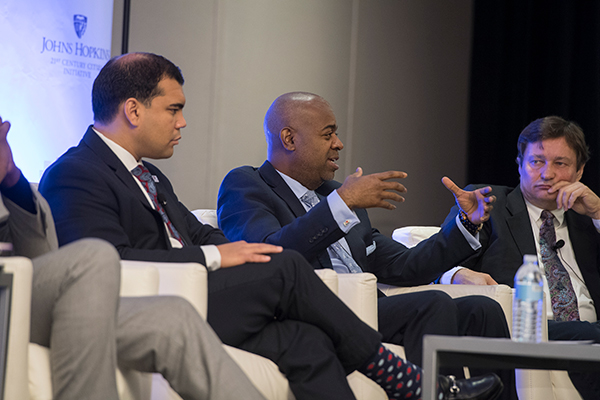
February 5, 2018
By Emily Warren, postdoctoral fellow, 21st Century Cities Initiative, Johns Hopkins University
At our 21st Century Neighborhoods symposium, held in Baltimore in December, Mayor Ras Baraka of Newark, New Jersey, outlined Newark 2020, a strategy for addressing growing economic inequality by connecting low-income Newark residents with local companies to hire 2,020 residents by 2020. The initiative relies on increased local hiring by Newark’s anchor institutions, such as Rutgers University-Newark, RWJBarnabas Health, and Prudential. This post describes anchor institutions, their potential roles in reducing economic and neighborhood inequality, and examples of partnerships between anchor institutions and local government.
What are anchor institutions?
Historically referring primarily to universities and health care systems, the definition of anchor institutions has expanded in recent years to encompass a variety of local for-profit and nonprofit organizations that have a significant geographic and/or market presence, especially in lower-income communities. Along with traditional “eds and meds,” anchors include financial institutions, arts and culture organizations, religious organizations, and utility companies. Anchor institutions are not necessarily only present in large cities, as small or mid-sized cities typically contain large employers that “anchor” the community’s economic landscape by providing a significant proportion of local employment and purchasing power.
Making Local Economic Impacts
While anchor institutions make important contributions to the local economy, they often have a complicated history with their host communities. The workforces of anchor institutions have not always reflected local community demographics, which means that local residents are often not able to fully benefit from their close proximity to anchor institutions. Jobs at anchor institutions tend to be relatively secure, well-paid, and offer health and retirement benefits, all of which are especially important to economically disadvantaged groups. And while anchor institutions spend significant amounts of money each year on good and services, a majority of those are often purchased from non-local vendors. Local procurement supports locally-owned businesses, which are more likely to be owned by and employ minorities and women. Procurement from vendors outside the area, in combination with a lack of local hiring, hinders the ability of anchor institutions’ economic power to have significant local impacts and to address local inequality.
Recent research on Newark’s anchor institutions highlighted these issues around local hiring and procurement. The New Jersey Institute for Social Justice found that in 2015 an estimated 18 percent of working-age Newark residents held jobs within the city. Studying six anchor institutions, which included both higher education and financial institutions, the Initiative for A Competitive Inner City (ICIC) found that in 2013, only 3 percent of the goods and services purchased by these institutions were purchased from Newark businesses. These trends have been a motivating force behind the creation of Newark 2020.
Strategies for Change
There are several strategies that cities and anchor institutions can pursue to help anchor institutions become more effective economic partners.
- Identify significant institutions. Cities, large and small, can use publicly available data to identify anchor institutions that may not fit the traditional definition but serve important roles. They can also use this information to measure levels of engagement by those institutions in local hiring and procurement to identify potential areas of collaboration and improvement. For example, the Federal Reserve Bank of St. Louis used mapping to identify anchor institutions along the Mississippi Delta. Using U.S. census data, researchers identified 14 anchor institutions based on the contributions of these organizations to the local economy relative to its size, and then examined areas of high poverty and unemployment located within or near the locations of these anchors.
- Hire more local residents. A common metric for capturing an anchor institution’s engagement is the proportion of its workforce comprised of local residents. Institutions can set local hiring goals but also identify barriers that area residents may face in obtaining or maintaining employment at local anchors, particularly transportation issues. As part of its HopkinsLocal initiative, Johns Hopkins University has pledged to make 40 percent of new hires in targeted employment categories from certain Baltimore zip codes identified as disadvantaged.
- Increase local procurement. Local institutions have enormous purchasing power for goods and service, and using local suppliers is an important strategy for contributing to the local economy. This strategy can include efforts to purchase from local vendors, especially minority-owned or women-owned businesses, and to examine contracting processes to identify any structural barriers that are preventing local vendors from successfully bidding on projects. Between 1996 and 2003, the University of Pennsylvania tripled the dollar amount of goods and services purchased from West Philadelphia businesses through their Economic Inclusion Initiative. Under their current plans, they continue to focus on local purchasing and aim to award 20 percent of all construction contracts to minority or women-owned businesses.
To learn more about how anchor institutions can expand economic opportunity and inclusion in their communities, read our policy brief: Private Sector Efforts to Support Economic Inclusion.
Watch a brief highlight video of the panel below. To watch the full panel, click here.

